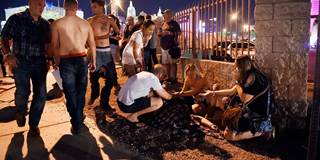Many details about Stephen Paddock’s reasons for opening fire on a Las Vegas concert last weekend have yet to be discerned. But so-called “lone wolf” mass shooters are not a new phenomenon, and past episodes can offer important clues about the thought processes and experiences that motivate them.
LONDON – This weekend, Stephen Paddock opened fire on a country music festival in Las Vegas, Nevada, from an overlooking hotel, killing at least 59 people and injuring more than 500 others. Paddock, a 64-year-old former accountant with no criminal record, was ultimately found in his hotel room, dead, with some 23 guns, including more than ten assault weapons. Police later found an additional 19 firearms, explosives, and several thousands of rounds of ammunition in Paddock’s home. What the authorities have not yet found, however, is a motive.
More details about Paddock’s mindset and objectives will probably come to light in the coming days. But so-called “lone wolf” mass shooters – individual perpetrators with no ties to any movement or ideology – are not a new phenomenon, and these episodes have offered important clues about the motivations and thought processes of mass shooters.
Most mass shooters do not survive their own attacks; they either kill themselves or let police do the job. But those who have survived have shown some common features, with narcissistic personality disorder and paranoid schizophrenia being the two most frequent diagnoses. That was the case with Anders Breivik, the Norwegian far-right terrorist who, in 2011, detonated a van bomb that killed eight people, before shooting dead 69 participants in a youth summer camp. He remains in prison in Norway.

LONDON – This weekend, Stephen Paddock opened fire on a country music festival in Las Vegas, Nevada, from an overlooking hotel, killing at least 59 people and injuring more than 500 others. Paddock, a 64-year-old former accountant with no criminal record, was ultimately found in his hotel room, dead, with some 23 guns, including more than ten assault weapons. Police later found an additional 19 firearms, explosives, and several thousands of rounds of ammunition in Paddock’s home. What the authorities have not yet found, however, is a motive.
More details about Paddock’s mindset and objectives will probably come to light in the coming days. But so-called “lone wolf” mass shooters – individual perpetrators with no ties to any movement or ideology – are not a new phenomenon, and these episodes have offered important clues about the motivations and thought processes of mass shooters.
Most mass shooters do not survive their own attacks; they either kill themselves or let police do the job. But those who have survived have shown some common features, with narcissistic personality disorder and paranoid schizophrenia being the two most frequent diagnoses. That was the case with Anders Breivik, the Norwegian far-right terrorist who, in 2011, detonated a van bomb that killed eight people, before shooting dead 69 participants in a youth summer camp. He remains in prison in Norway.